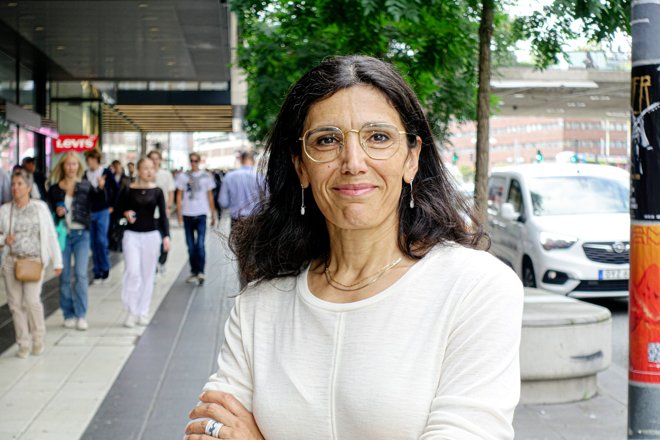The physician at the tech giant: “Observations in the emergency room made my mind up”

In early 2012, Nasim Farrokhnia took the position as Head of Emergency Department at Södersjukhuset in Stockholm. Nasim, a physician specialising in internal medicine, had recently completed her postdoc in evidence-based healthcare at SBU, the Swedish National Board for Health and Social Evaluation. Her new workplace was the largest emergency unit in northern Europe, and it was often cluttered.
“The thoughts that brought me to where I am today probably arose there and then. My observations in the emergency room made me make my mind up,” she said when we met at Microsoft’s Stockholm office on a Friday afternoon in late summer.
Around the time when Nasim Farrokhnia started at Södersjukhuset, several technological leaps were made. Smartphones had become part of everyone’s daily life, ´big data´ was an increasingly discussed concept, and cloud services were being introduced in many workplaces. Nasim wanted a structured and evidence-based approach in the emergency department, and she realised that the new technology could help.
“The administrative burden was heavy for both doctors and nurses, and this was also the case for us. Waiting times were long, and we also needed a better overview of patients, samples, tests and referrals in real-time in order to improve work planning. Staff called for better tools for visualisation and communication with, for example, the radiology department.
Nasim introduced procedures using new technology as a tool, and used data to map when most patients came to the emergency unit.
“This knowledge could then be used for scheduling based on need, ensuring that we were ready when patient pressure was at its peak.”
In 2018, she left the emergency department for a position as Head of Research and Education at healthcare company Kry. After three years, she moved on to online psychologist Mindler, where she became Head of Sweden.
For Nasim Farrokhnia, there is a correlation between her interest in healthcare and technology. She feels that engineers and doctors have a lot in common.
“I am married to a fourth-generation engineer, and my father-in-law is an inventor. Engineers are often very focused on solutions, and we doctors also solve problems, so we have a common denominator.”
About a year and a half ago, she joined Microsoft as a Healthcare Manager in the company’s Western Europe team. Microsoft, one of the world’s leading tech companies in cloud services, software and computing, needs no introduction, but not everyone is aware that healthcare is an important sector for the tech giant.
Nasim Farrokhnia
Age: 51.
Family: Husband and five children, including three stepchildren. The youngest child is 17.
Born: Tehran, Iran.
Lives: Bromma in Stockholm.
Leisure interests: Extra work as a group exercise instructor at the SATS gym. “Also, the need to spend time in the great outdoors and reflect has grown over the years.”
Last book read: Dreams from My Father by Barack Obama.
“Microsoft has agreements with all regions in Sweden, and our customers include both public and private healthcare providers. We often meet with them to find out which challenges they face in different hospitals and what we can do to solve them.”
One challenge can be the special consideration of security and patient privacy when conducting video conferences. Many healthcare providers use the conferencing software Microsoft Teams, and sometimes, special adaptations are necessary to make it work within the context of the healthcare system. Nasim Farrokhnia has both on-site and remote meetings with hospitals and healthcare facilities, which may involve customising the use of Microsoft’s software for a clinic or implementing new AI solutions. However, her work also extends to another level.
“To be able to use AI tools, you need access to data, and these are issues that lie with decision-makers at regional or national level. Therefore, it is not just about trying to help clinics x, y and z because policymakers need to create the right framework for local actors to use new technologies, which is why I have many meetings with people who have the power to influence such things. It is part of my job to participate in conferences, and panels and to collaborate across the EU.”
We conclude by talking about role models. Nasim mentions Hans Rosling, a renowned professor of international healthcare, who founded the Gapminder Foundation, aiming to contribute to a fact-based worldview that everyone can understand.
Her childhood hero, Marie Curie, has remained a role model even in adulthood.
“Marie and her sister were the first women to study at the Sorbonne University in Paris. Last summer, my daughter bought tickets to a Harry Styles concert in Warsaw. I liked that idea, so I joined her and visited the Marie Curie Museum in the city at the same time. The museum is in her childhood home, with furniture from her and her husband Pierre’s home and laboratory in Paris. With her two Nobel Prizes and her contribution to science, Marie Curie is still unique in the world.”
This artcile has also been published in Life Science Sweden´s sister magazine Medtech Magazine
Artikeln är en del av vårt tema om News in English.
 Av
Av